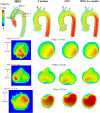Validation of numerical simulation methods in aortic arch using 4D Flow MRI
- PMID: 28444501
- PMCID: PMC5519664
- DOI: 10.1007/s00380-017-0979-2
Validation of numerical simulation methods in aortic arch using 4D Flow MRI
Abstract
Computational fluid dynamics (CFD) are the gold standard in studying blood flow dynamics. However, CFD results are dependent on the boundary conditions and the computation model. The purpose of this study was to validate CFD methods using comparison with actual measurements of the blood flow vector obtained with four-dimensional (4D) flow magnetic resonance imaging (MRI). 4D Flow MRI was performed on a healthy adult and a child with double-aortic arch. The aortic lumen was segmented to visualize the blood flow. The CFD analyses were performed for the same geometries based on three turbulent models: laminar, large eddy simulation (LES), and the renormalization group k-ε model (RNG k-ε). The flow-velocity vector components, namely the wall shear stress (WSS) and flow energy loss (EL), of the MRI and CFD results were compared. The flow rate of the MRI results was underestimated in small vessels, including the neck vessels. Spiral flow in the ascending aorta caused by the left ventricular twist was observed by MRI. Secondary flow distal to the aortic arch was well realized in both CFD and MRI. The average correlation coefficients of the velocity vector components of MRI and CFD for the child were the highest for the RNG k-ε model (0.530 in ascending aorta, 0.768 in the aortic arch, 0.584 in the descending aorta). The WSS and EL values of MRI were less than half of those of CFD, but the WSS distribution patterns were quite similar. The WSS and EL estimates were higher in RNG k-ε and LES than in the laminar model because of eddy viscosity. The CFD computation realized accurate flow distal to the aortic arch, and the WSS distribution was well simulated compared to actual measurement using 4D Flow MRI. However, the helical flow was not simulated in the ascending aorta. The accuracy was enhanced by using the turbulence model, and the RNG k-ε model showed the highest correlation with 4D Flow MRI.
Keywords: Computational fluid dynamics; Flow energy loss; Phase-contrast MRI; Wall shear stress.
Conflict of interest statement
Dr. Keiichi Itatani is an equity shareholder and founder of the venture vendor for a blood flow analysis tool: Cardio Flow Design Inc. (Tokyo, Japan). Dr. Keiichi Itatani is an endowed chair financially supported by Medtronic Japan (Tokyo, Japan). Dr. Teruyasu Nishino is an equity shareholder and CEO of the venture vendor for a blood flow analysis tool: Cardio Flow Design Inc. (Tokyo, Japan).
Figures








Similar articles
-
Neonatal aortic arch hemodynamics and perfusion during cardiopulmonary bypass.J Biomech Eng. 2008 Dec;130(6):061012. doi: 10.1115/1.2978988. J Biomech Eng. 2008. PMID: 19045541
-
Characteristics of transition to turbulence in a healthy thoracic aorta using large eddy simulation.Sci Rep. 2025 Jan 25;15(1):3236. doi: 10.1038/s41598-025-86983-z. Sci Rep. 2025. PMID: 39863653 Free PMC article.
-
Validation of Numerical Simulations of Thoracic Aorta Hemodynamics: Comparison with In Vivo Measurements and Stochastic Sensitivity Analysis.Cardiovasc Eng Technol. 2018 Dec;9(4):688-706. doi: 10.1007/s13239-018-00387-x. Epub 2018 Oct 24. Cardiovasc Eng Technol. 2018. PMID: 30357714
-
A comparison of 4D flow MRI-derived wall shear stress with computational fluid dynamics methods for intracranial aneurysms and carotid bifurcations - A review.Magn Reson Imaging. 2018 May;48:62-69. doi: 10.1016/j.mri.2017.12.005. Epub 2017 Dec 6. Magn Reson Imaging. 2018. PMID: 29223732 Review.
-
New imaging tools in cardiovascular medicine: computational fluid dynamics and 4D flow MRI.Gen Thorac Cardiovasc Surg. 2017 Nov;65(11):611-621. doi: 10.1007/s11748-017-0834-5. Epub 2017 Sep 19. Gen Thorac Cardiovasc Surg. 2017. PMID: 28929446 Review.
Cited by
-
Optimizing encoding strategies for 4D Flow MRI of mean and turbulent flow.Sci Rep. 2024 Aug 27;14(1):19897. doi: 10.1038/s41598-024-70449-9. Sci Rep. 2024. PMID: 39191846 Free PMC article.
-
Modeling Flow in an In Vitro Anatomical Cerebrovascular Model with Experimental Validation.bioRxiv [Preprint]. 2023 Feb 2:2023.01.13.523948. doi: 10.1101/2023.01.13.523948. bioRxiv. 2023. Update in: Front Med Technol. 2023 Feb 23;5:1130201. doi: 10.3389/fmedt.2023.1130201. PMID: 36711518 Free PMC article. Updated. Preprint.
-
Medical Image-Based Computational Fluid Dynamics and Fluid-Structure Interaction Analysis in Vascular Diseases.Front Bioeng Biotechnol. 2022 Apr 27;10:855791. doi: 10.3389/fbioe.2022.855791. eCollection 2022. Front Bioeng Biotechnol. 2022. PMID: 35573253 Free PMC article. Review.
-
Differences in blood flow dynamics between balloon- and self-expandable valves in patients with aortic stenosis undergoing transcatheter aortic valve replacement.J Cardiovasc Magn Reson. 2023 Oct 26;25(1):60. doi: 10.1186/s12968-023-00970-9. J Cardiovasc Magn Reson. 2023. PMID: 37880721 Free PMC article.
-
Clinical Applications of 4D Flow MR Imaging in Aortic Valvular and Congenital Heart Disease.Magn Reson Med Sci. 2022 Mar 1;21(2):319-326. doi: 10.2463/mrms.rev.2021-0030. Epub 2021 Jun 25. Magn Reson Med Sci. 2022. PMID: 34176866 Free PMC article. Review.
References
-
- Sughimoto K, Shimamura Y, Tezuka C, Tezuka C, Tsubota K, Liu H, Okumura K, Masuda Y, Haneishi H. Effects of arterial blood flow on walls of the abdominal aorta: distributions of wall shear stress and oscillatory shear index determined by phase-contrast magnetic resonance imaging. Heart Vessels. 2016;31:1168–1175. doi: 10.1007/s00380-015-0758-x. - DOI - PubMed
Publication types
MeSH terms
LinkOut - more resources
Full Text Sources
Other Literature Sources
Medical
Research Materials
Miscellaneous

